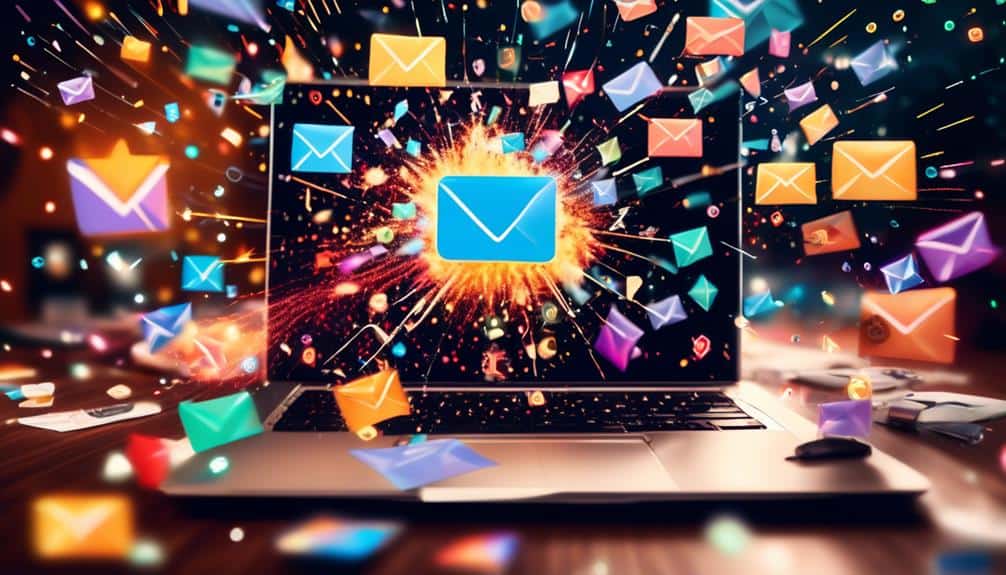Alert: Are You Using These Powerful Email Marketing Strategies Yet?
You've probably heard the saying, 'The money is in the list.' Well, it's true. Your email list is a powerful tool for reaching your audience and driving sales.
But are you maximizing its potential? There are some key email marketing strategies that can take your campaigns to the next level and deliver impressive results.
From personalization to behavioral tracking, these techniques can help you connect with your subscribers on a deeper level and increase your chances of success.
So, if you're not already using these powerful strategies, you may be missing out on a whole new level of email marketing success.
Key Takeaways
- Personalization and segmentation are essential for effective email marketing strategies. By utilizing customized recommendations, individualized subject lines, and tailored email experiences, marketers can increase conversion rates and demonstrate value to recipients.
- Targeted audience groups should be understood in terms of their unique characteristics and preferences. By tailoring email marketing strategies to meet their specific needs, marketers can improve email analytics, deliverability, and audience engagement, leading to increased conversion rates and customer satisfaction.
- Personalized content delivery is crucial for driving customer engagement and enhancing the overall experience. By tailoring email content to meet specific needs and preferences and implementing dynamic messaging based on demographics and behavior, marketers can build stronger relationships and foster brand loyalty.
- Automation is a valuable tool for streamlining the email marketing process, saving time, and increasing engagement. By automating repetitive tasks and nurturing subscribers through the customer journey, marketers can focus on other important aspects of the business and deliver targeted messages that drive conversions.
Personalization

Personalize your email marketing campaigns to engage and connect with your audience on a deeper level. By utilizing customized recommendations and individualized subject lines, you can create a tailored experience that resonates with each recipient.
Customized recommendations are a powerful tool to enhance the personalization of your email marketing campaigns. By analyzing user data and preferences, you can provide targeted product suggestions that align with their interests and needs. This not only increases the chances of conversion but also shows your audience that you understand their unique preferences and value their individuality.
Another effective way to personalize your email campaigns is through individualized subject lines. A generic subject line might go unnoticed in a crowded inbox, but a personalized one grabs attention and increases the likelihood of your email being opened. By including the recipient's name or referencing their recent activity, you can make your email stand out and create a sense of relevance.
Segmentation
Segmentation is a crucial aspect of email marketing that involves dividing your audience into targeted groups. By segmenting your audience based on factors like demographics, interests, and behaviors, you can deliver personalized content that resonates with each group.
This not only increases the relevance of your emails but also boosts conversion rates, as recipients are more likely to engage with content that speaks directly to their needs and interests.
Targeted Audience Groups
To effectively reach and engage your audience, understanding their unique characteristics and preferences is crucial. By segmenting your audience into targeted groups, you can tailor your email marketing strategies to meet their specific needs. Here are three reasons why audience segmentation is essential for successful email marketing:
- Improved Email Analytics: By segmenting your audience, you can gather more accurate and insightful data about how your emails are performing. This allows you to identify trends, measure engagement, and make data-driven decisions to optimize your email campaigns.
- Increased Email Deliverability: Sending relevant and personalized emails to specific audience segments improves your email deliverability rates. By delivering content that resonates with your recipients, you reduce the risk of your emails being marked as spam or unsubscribed from.
- Enhanced Audience Engagement: When you segment your audience and send targeted emails, you can provide them with content that's relevant to their interests and preferences. This increases the likelihood of them opening, reading, and engaging with your emails, leading to higher conversion rates and customer satisfaction.
Segmenting your audience is a powerful strategy that can significantly impact the success of your email marketing campaigns. Take the time to understand your audience and create targeted groups to optimize your email marketing efforts.
Personalized Content Delivery
Tailoring your email content to meet the specific needs and preferences of your audience groups is essential for maximizing engagement and conversion rates.
By implementing personalized content delivery, you can create a more meaningful and relevant experience for your subscribers.
Dynamic messaging allows you to create different versions of your email based on various factors such as demographics, past purchase behavior, or even browsing history.
This level of personalization not only increases customer engagement but also enhances the overall customer experience.
By delivering content that resonates with your audience on a personal level, you can build stronger relationships and foster brand loyalty.
Don't underestimate the power of personalized content delivery in driving higher engagement and ultimately, increasing conversions.
Start implementing this strategy today and see the impact it has on your email marketing campaigns.
Increased Conversion Rates
By analyzing and segmenting your email list, you can significantly boost your conversion rates. Here's how:
- Customize email subject lines: Personalize your subject lines based on the recipient's interests, preferences, or past interactions. This grabs their attention and increases the chances of them opening your email.
- Tailor call to action (CTA) strategies: Segment your audience based on their behavior and preferences, then create targeted CTAs that resonate with each group. Whether it's a limited-time offer, a personalized discount, or a compelling message, make sure your CTAs are clear, persuasive, and tailored to the specific needs of each segment.
- Test and optimize: Continuously test different email subject lines and CTAs to identify what works best for each segment. Use A/B testing to compare different approaches and optimize your email marketing strategy for maximum conversion rates.
Segmentation allows you to send more relevant and personalized emails, increasing engagement and ultimately driving higher conversion rates.
Automation
Automation streamlines your email marketing process, allowing you to save time and deliver targeted messages to your audience with ease. By utilizing automated campaigns and email sequencing, you can create a personalized experience for your subscribers, increasing engagement and driving conversions.
Take a look at the table below to see the benefits of automation in email marketing:
| Benefits of Automation | Emotion Evoked |
|---|---|
| Saves time | Relief |
| Delivers targeted messages | Excitement |
| Increases engagement | Confidence |
With automation, you can set up a series of emails that are triggered based on specific actions or behaviors of your subscribers. This allows you to nurture and guide them through the customer journey, providing relevant content at each stage. By delivering targeted messages, you can grab their attention, build trust, and ultimately drive them to take action.
Automation also saves you time by automating repetitive tasks such as sending welcome emails, follow-ups, and abandoned cart reminders. Instead of manually sending individual emails, you can set up automated campaigns to handle these tasks for you, freeing up your time to focus on other important aspects of your business.
Mobile Optimization

Are you struggling to get your emails noticed on mobile devices?
With the majority of people now checking their emails on their smartphones, it's crucial to optimize your emails for mobile.
By using responsive email design, you can ensure that your emails adapt to different screen sizes and provide a seamless experience for your subscribers.
This not only increases the chances of your emails being opened, but also improves the overall user experience and engagement.
Responsive Email Design
What is the best way to optimize your email design for mobile devices?
With the rise of smartphones, it's essential to ensure that your email campaigns are mobile-friendly. Here are three email design trends and email marketing tactics to help you create responsive email designs that look great on any device:
- Simplify your layout: Keep your email design clean and uncluttered. Use a single-column layout and prioritize important content.
- Use responsive templates: Choose email templates that automatically adjust to different screen sizes. This ensures that your emails look great on both desktop and mobile devices.
- Optimize images and fonts: Use images and fonts that are optimized for mobile viewing. Compress your images to reduce file size and choose fonts that are easy to read on smaller screens.
Increasing Open Rates
To increase open rates and optimize for mobile devices, focus on crafting compelling subject lines that grab the attention of your audience. A well-crafted subject line can significantly impact email deliverability and encourage recipients to open your emails. Here are some strategies to consider when creating subject lines:
| Strategy | Example |
|---|---|
| Personalization | "John, don't miss out on this exclusive offer!" |
| Urgency | "Limited time: 50% off ends tonight!" |
| Curiosity | "Unlock the secret to boosting your sales." |
| Benefit-driven | "Increase your email open rates by 50% with these tips." |
A/B Testing
Increase your email marketing success by incorporating A/B testing into your strategy. A/B testing, also known as split testing, allows you to compare different versions of your emails to determine which one performs better. Here are three reasons why A/B testing is essential for email optimization and conversion optimization:
- Identify the most effective subject lines: With A/B testing, you can test different subject lines to see which ones generate higher open rates. By understanding what resonates with your audience, you can create compelling subject lines that grab their attention and encourage them to open your emails.
- Optimize your email content: A/B testing enables you to experiment with different email layouts, copy, and visuals. By testing different elements, you can determine which variations lead to higher click-through rates and conversions. This valuable insight allows you to refine your email content and deliver messages that resonate with your subscribers.
- Improve your call-to-action (CTA): A/B testing allows you to test different CTAs to see which ones drive the most clicks and conversions. By optimizing your CTAs, you can create a sense of urgency, offer irresistible incentives, and guide your subscribers towards the desired action.
Incorporating A/B testing into your email marketing strategy empowers you to make data-driven decisions that maximize your email performance. By continuously testing and optimizing your emails, you can drive higher engagement, conversions, and ultimately, achieve your email marketing goals.
Behavioral Tracking

Now that you have optimized your email content and CTAs through A/B testing, it's time to take your email marketing strategy to the next level with behavioral tracking.
Behavioral tracking allows you to gain valuable insights into your subscribers' actions and preferences, enabling you to deliver more personalized and effective email campaigns.
By analyzing the behavior of your subscribers, you can understand their interests, preferences, and engagement patterns. This behavioral analysis helps you segment your email list and tailor your content to specific groups, increasing the relevance of your messages and driving higher email engagement.
With behavioral tracking, you can track various actions, such as email opens, link clicks, and website visits. By monitoring these behaviors, you can identify your most engaged subscribers and create targeted campaigns to nurture and convert them into loyal customers.
Furthermore, behavioral tracking allows you to automate your email marketing efforts based on specific triggers. For example, if a subscriber clicks on a particular link in your email, you can automatically send them a follow-up email with more information or a special offer related to their interest.
Incorporating behavioral tracking into your email marketing strategy empowers you to deliver more tailored and relevant content, boost engagement, and ultimately drive better results.
Frequently Asked Questions
How Does Personalization in Email Marketing Help Improve Customer Engagement and Conversion Rates?
Using personalization in email marketing helps improve customer engagement and conversion rates. By tailoring content and offers to individual preferences, you can increase open rates and click through rates, resulting in more effective and successful email campaigns.
What Are Some Effective Ways to Segment Your Email List for More Targeted and Relevant Campaigns?
Segmenting your email list is crucial for more targeted and relevant campaigns. By dividing your subscribers based on their preferences, demographics, or behaviors, you can send personalized content that resonates with them, leading to higher engagement and conversion rates.
Can You Provide Examples of How Automation Can Streamline Email Marketing Processes and Save Time?
Automation benefits in email marketing include time-saving techniques such as setting up drip campaigns, creating personalized triggers, and automating follow-ups. These strategies streamline processes, allowing you to focus on serving your audience effectively.
Why Is Mobile Optimization Important in Email Marketing, and What Best Practices Should Be Followed?
Mobile optimization is crucial in email marketing. By ensuring your emails are easily readable on mobile devices, you can reach a wider audience. Follow best practices like using responsive design and concise content to maximize engagement.
How Does A/B Testing Benefit Email Marketing Campaigns, and What Are Some Key Elements to Test for Optimal Results?
A/B testing is vital for email marketing campaign success. It helps optimize results by testing different elements. Test subject lines, call-to-action buttons, and visuals to improve open rates, click-through rates, and conversions.
Conclusion
Don't miss out on the power of email marketing strategies!
Take advantage of personalization, segmentation, automation, mobile optimization, A/B testing, and behavioral tracking to boost your campaign's success.
By implementing these strategies, you can engage your audience, increase conversions, and maximize your ROI.
Stay ahead of the competition and unlock the full potential of email marketing today.
Get started and watch your business thrive!








